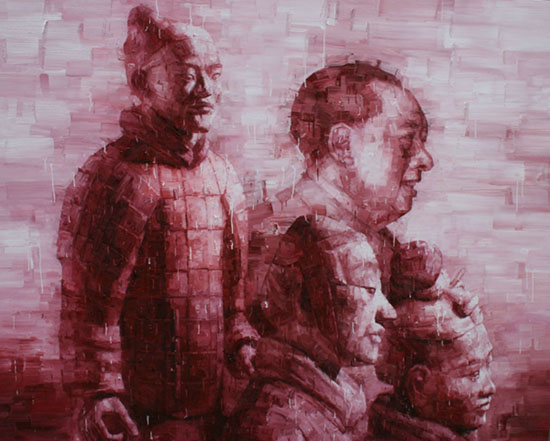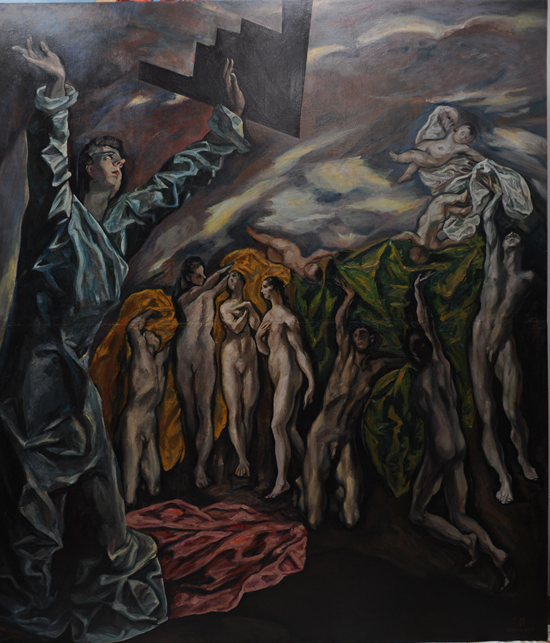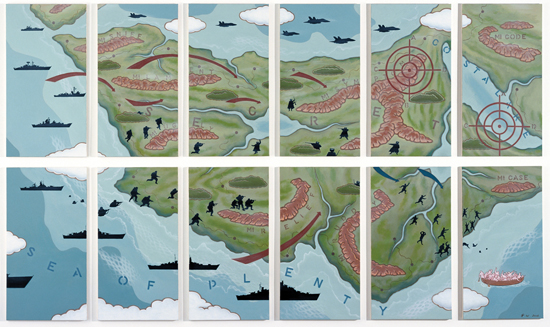Luise Guest finds images that suggest psychological warfare in the works of three contemporary painters…
Watching the TV series China: Triumph and Turmoil it was evident to me that the way China was governed in the Warring States period with absolute power by Emperor Qin Shi Huang (he of the terracotta army) has many resonances with more recent history – and not only in China. The image of the entombed warriors is an enduring symbol of paranoia, power, fear and megalomania. Contemporary parallels are not hard to find.
The Price of War is an exhibition of works by nine Chinese/Australian artists organised by the University of Sydney Confucius Institute and Chinalink Gallery, with the aim of promoting peace and tolerance. A laudable intention, and an exhibition which includes artists of the calibre of Shen Jiawei and Guan Wei is certainly worth seeing. The exhibition itself, however, at first seems a little odd. The works range from accomplished paintings by significant artists with international careers, to installations and paintings by emerging artists .They present a variety of responses to the theme which I initially thought reflected the individual position taken by each artist, rather than a coherent curatorial narrative. Yet, after I walked through the gallery thinking about the relationship of one work to the next, a narrative did emerge – and, yes, it does seem to link back to those ubiquitous terracotta warriors and the symbolism they embody.
Adam Chang, ‘Mao Guarded by Standing Terracotta Soldier’, 2012, oil on canvas, 220 x 300 cm, image courtesy of the artist.
Zhong Chen uses imagery from traditional Chinese ink paintings applied in a deliberately crude and expressionist manner to reflect on his transcultural identity. ’Untitled’ is populated by Chinese Opera characters representing traditional Imperial warriors. They appear to be looming over the battlements of a walled city, lined up in a row. Like a number of other artists in this exhibition, Zhong arrived in Australia in 1989. A touching essay in the catalogue by Xing Jin, the General Manager of the University of Sydney Confucius Institute, recalls the days when she and many of the artists, including Shen Shaomin, were attempting to make a new life in Australia. Speaking little or no English they worked as cleaners, factory workers, or waiters and experienced an overwhelming sense of loneliness, oppression and loss. She identifies that time as the source of the strong beliefs that underpin the works in the exhibition. That sense of powerlessness in the face of forces too great to resist can be seen – obliquely or overtly – in many of the works here, particularly in those of the older artists.
On the ground floor Shen Jiawei presents two enormous and ambitious works appropriated from El Greco’s Laocoon and The Opening of the 5th Seal, demonstrating his characteristically bravura technical accomplishment and his ambition of scale and intent. There is some awkwardness in the juxtaposition of dramatically lit, etiolated nudes with the representation of a burning Manhattan, intended to evoke the horrors of 9/11. The B2 stealth bomber painted into the sky above the figures from El Greco’s ‘The Opening of the Fifth Seal’ – the moment in the Book of Revelation when the souls of martyrs appeal to God to avenge their blood – is a little obvious, and the artist has said that he struggled with the transformation of historical works to create new meanings for a contemporary audience. But the works are dramatic and powerful – and after all, who but an artist trained in the technical virtuosity of the Chinese academy would even attempt such a heroic act of painterly hubris? There is no doubting the artist’s sincerity. Speaking at the gallery last weekend, he made explicit the connections in his mind between the horrors of the Boxer Rebellion and the killings of civilian populations in any war – from China in the past to Iraq, Afghanistan or Syria right now.
“Shen Jiawei, ‘The Opening of the Fifth Seal after El Greco’, 2004 – 2012, oil on canvas, 300 x 260 cm, image courtesy of the artist”
On the opposite wall, two monumental works by Adam Chang make even more explicit the connections made by these artists, with their very particular backgrounds and life stories, between past events and present-day atrocities. ‘Mao Guarded by Standing Terracotta Soldier’ is juxtaposed with ‘Australian Soldier’. In the first painting, Mao appears in a group of three terracotta warriors, and is represented as one of them, rather than as the omnipotent Emperor. This raises some interesting questions, not least about the current fashionability of ‘retro’ Mao imagery both in China and in the west. The artist has said he wanted to make a comparison between historical and modern soldiers, and about the way that decisions made by the powerful play out in the lives of ordinary people. Recently his inspiration has come from watching news stories about the casualties in Afghanistan, and the impact of war on the innocents, such as the children of Australian soldiers killed in action on someone else’s battlefield. The sense of the futility of war in these works is palpable, and one understands that the intention of the curator is to make apparent the sameness of war, its unspeakable universality. In his catalogue essay John McDonald writes: ‘This is the price of war today: not the brutal battles and millions of civilian deaths as seen in Chinese history, but a slow, painful withering away of self-respect and heroic ideals.’
In contrast to these monumental works, a quiet installation by Amy Fu, ‘From Sound of Foetus’, presents a female perspective. Neon tubes outline embryos held within bandaged female torsos, evoking the grief and suffering of women and children. Hidden away in a corner of the gallery is one of the most interesting and evocative works in the show. Tianli Zu’s A Wonderful World is a dream-like and evocative stop-motion animation based on paper-cutting, employing the shadows cast by her delicate paper forms to create a mysterious narrative. Her work is about how we face our deepest fears, and confront the shadows in our lives. She likens this to the Chinese philosophy of yin and yang, and to the influence of a culture in which what is hidden is as important as what is revealed. Like a number of artists working within China who are reinventing traditional art and craft forms in new ways (the paper-cutting works of Chen Hangfeng or Wu Junyong, for example, which have been shown in exhibitions in Sydney and Melbourne ) she has taken an ancient form and created something new and compelling. The combination of the dreamlike images and soundtrack is very beautiful, evoking in the viewer ideas about the natural world and technological interventions.
Guan Wei, ‘Where’s Ned Kelly?’, 2004, acrylic on canvas, 180 x 306 cm (12 panels) image courtesy of the artist.
Guan Wei’s ‘Where’s Ned Kelly?’ employs his characteristic iconography of maps, clouds and miniature silhouetted figures to create a discomfiting world where the figures of US soldiers pursue tiny fleeing figures both white and black into the sea, and engage multiple Ned Kellys in combat. War planes fly overhead. Battleships patrol the ‘Sea of Plenty’. A boatload of refugees paddles away from the shore – or possibly towards it. They are faceless but for their screaming mouths. The artist has said that he painted this work in 2004 as a response to the way he felt in New York in the years following September 11, when fear and hatred enveloped the city. It’s not hard to think of some other parallels though – the prospect of the Australian Navy being ordered to tow refugee boats back to Indonesia does rather spring to mind. The alternative title of this work, ‘Looking for Enemies’ reveals the horror of living in a state of heightened paranoia and fear. The artist’s own migration to Australia, an experience echoing numerous Chinese Diasporas, and his global wanderings since that time, is a source of his repeated motifs of islands, water and drifting clouds. Traditionally in Chinese art clouds signify good fortune. Here they rather suggest that the violent ends of tiny humans are so insignificant that the gods are taking no notice, and the universe moves on.
The Price of War
Chinalink Gallery until 25 August.



